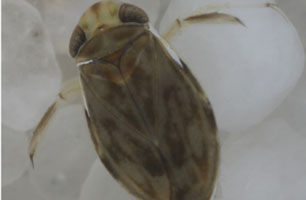
Jerome Sueur
With so much talk about how Africa’s rhinos and Russia’s tigers are steadily vanishing from our planet, it’s easy to forget that other, smaller species – apple snails, dung beetles, tree frogs – are worthy of attention as well, even if they aren’t as charismatic. Some of these creatures are as remarkable as they are obscure. One such animal has just gotten its day in the sun, thanks to a study published in PLoS One. The critter is an insect, known as the “water boatman,” or Micronecta scholtzi. These little guys are the world’s loudest animals relative to their body size and can attain volumes up to 99.2 decibels when they sing. That’s louder than a subway and about the same volume as a diesel truck. Listen to a quieter version of their calls here.
Fortunately for folks trying to take a quiet walk near a river in which the water boatmen live, 99% of sound is lost when transferring from the aquatic environment in which the insects live to the air. Still, the song is so loud that that remaining 1% can be audible.
No matter how much sound makes it to our ears it’s impressive, considering that the water boatmen are less than half an inch long. Male Micronecta Scholtzi use their song as a mating call, serenading their sweethearts by rubbing their genitalia against their abdomens — a phenomenon called stridulation, which is the same way crickets produce their nighttime calls. “Such an extreme display may be interpreted as an exaggerated secondary sexual trait resulting from a runaway sexual selection without predation pressure,” the authors wrote. In other words: the bugs are on the menu of few or none of the animals with which they share their river so they can afford to be as loud as they want.
None of that means that the researchers understand quite how the little insect became the boom box it is. The stridulating organ is only about the width of a human hair and there are no obvious body or external resonating systems that could amplify the sound. “We really don’t know how they make such a loud sound using such a small area,” said engineering expert James Windmill from the University of Strathclyde in Glasgow.
And what about the water boatwomen? Do the females of the species like all the noise the boys are making? That’s unclear so far, but the scientists are hoping to conduct playback experiments to test female preference for loud over soft calls. Regardless, the Micronecta scholtzi deserve the perhaps fleeting attention they’re getting, both because they’re one more reminder of the wonders of biodiversity and because, well, tiny animals that can make such noise are just pretty darn cool.


